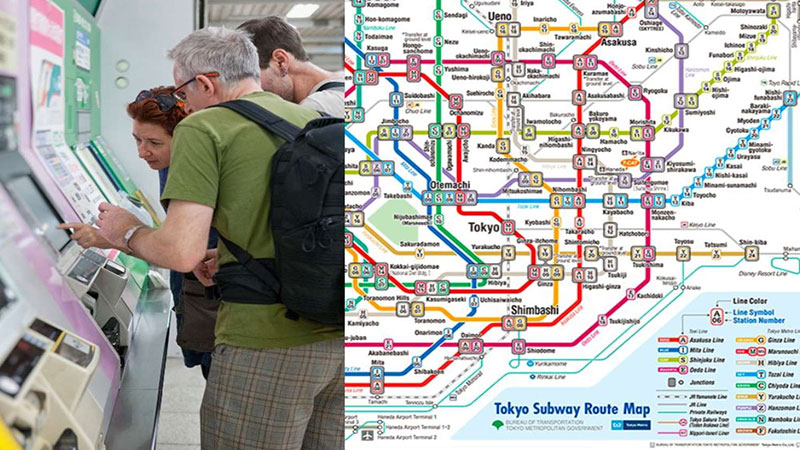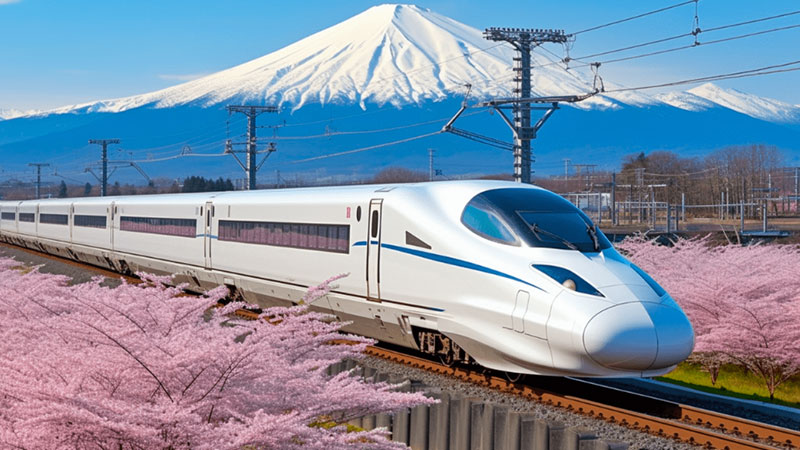Clean, safe, orderly and a great way to get around are some of the most obvious features of Japan‘s subway. This public transportation system is widely developed in major Japanese cities such as Tokyo, Osaka, and Nagoya, and is known as the main pillar of urban transportation in Japan. In other words, it can be said that the Japanese subway is one of the most advanced, efficient and complex public transportation systems in the world. Here are some of the features and highlights of Japan’s subways.
A brief history of Japan’s subway
The history of Japan’s subway goes back to the early 20th century, the peak of the country’s rapid development in the field of urban transportation. In the following, we review the most prominent historical points in the history of Japan’s subway:
The first subway line (1920s)
Japan’s first subway line was opened on December 30, 1927 in Tokyo. This line, which connected from Asakusa to Ueno, was built by the Tokyo Underground Railway Company. This line was the first metro line in Asia.
The state of subway lines after World War II
After the end of the Second World War and the reconstruction of Japan, the development of the subway was placed as one of the priorities of urban transportation. During this period, more lines were added to the metro network in response to the rapid population growth and economic development.

Japan’s extensive subway network in Tokyo and other cities
In the 1960s and 1970s, more lines were built in Tokyo and the subway expanded to other cities such as Osaka, Nagoya, and Yokohama. Today, the Tokyo subway network is one of the most complex and widely used subway systems in the world.
Advanced technology in Japan’s subway
Japan quickly implemented advanced technologies such as automatic train control (ATO) systems and modern safety systems in its subway system. These technologies played an important role in increasing the efficiency and security of the metro network.
Implementation of green transportation plan
In recent decades, Japan has focused on reducing the environmental impact of subways by using renewable energy and energy-efficient technologies.
The current state of the Japanese subway
Today, the subway in Japan is one of the main pillars of urban and intercity transportation. The Tokyo subway network alone has more than 13 lines and moves millions of passengers daily. Cities like Osaka and Kyoto are other Japanese cities that have advanced subway networks. In general, it can be said that the Japanese subway is a symbol of advanced engineering, efficiency and response to urban needs in one of the most populous countries in the world.

Japan subway door
In recent years, major improvements have been made in providing multilingual support in Japan’s subway systems, making commuting much easier for tourists. Even ticket machines, station names, as well as metro maps and guides in local areas are often presented in a number of live languages.
In larger cities such as Tokyo and Osaka, most subway stations are quite organized. Since the ticket can be more expensive if you change the lines, so before doing anything, it is better to check the map closely to see which train lines you can reach your destination more easily. Another important point is that you can use your Suica card as well as some other local IC cards to use the metro.

At some of the larger stations, passengers don’t need to exit the station to change lines and only need to change trains, which can be a bit confusing, so be aware of this when exiting the ticket gates. If you are not sure about the ticket price, simply buy the cheapest one and adjust the fare when you leave your destination. (There are fare adjustment machines next to the ticket gates.)
Read more: Getting to know Japan’s high-speed sleeper trains
Features of Japan’s subway
As one of the most important and widely used public transportation systems in Japan, the subway has the following features:
Japan’s extensive and complex subway system
The city of Tokyo alone has one of the largest subway networks in the world. The network consists of several subway lines organized by different companies such as Tokyo Metro and Toei Subway.
Efficiency and accuracy
High punctuality is one of the prominent features of the Japanese subway. In this country, trains are rarely late and their schedules are strictly followed.
High capacity
Japan’s subways move a lot of people, especially during rush hour. To the extent that in some cases, special staff called Oshiya are used to help passengers fit into the carriages.

Use of advanced systems
Japan’s subways have modern facilities such as automatic announcement systems, digital displays to inform passengers and smart payments. IC cards such as Suica and Pasmo are also used for easier fare payment.
Safety and cleanliness are prominent features of the Japanese subway
Japan’s subway stations and trains are incredibly clean. Also, security cameras and the presence of trained staff at the stations increase the safety of passengers.

Design and architecture
Many subway stations in Japan have a modern and beautiful design. Some stations, such as Shinjuku Station or Tokyo Station, are very famous and well-known due to their special architecture and the presence of connecting lines.
Wide connection system
The subway is connected to other transportation systems such as bullet trains (shinkansen) and buses, making intercity and intracity travel very convenient.

Train and subway tickets in Japan
The rail transportation system in Japan includes high-speed trains (Shinkansen), urban trains, and subways. There are different types of train and subway tickets in Japan that are designed to meet the needs of travelers:
Single Ticket
- For one-way trips between two stations.
- The price is calculated based on the distance.
- It can be purchased from ticket machines at stations.
Rechargeable cards (IC Cards)
- Cards like Suica and Pasmo for frequent trips.
- Can be used on trains, subways, buses, and even shopping in stores.
- Rechargeable and suitable for local travelers and tourists.
Unlimited passes (Rail Pass)
- Japan Rail Pass: For foreign tourists who want to use JR trains (Shinkansen and other JR lines) indefinitely.
- Local passes such as Tokyo Subway Pass or Kansai Thru Pass for unlimited use in a specific area.
Discount tickets
- For group trips, students or special occasions.
- Some lines offer daily or weekend tickets.

How to buy a subway ticket in Japan
- Automatic ticket machines: Bi- or multilingual (usually Japanese and English) machines are available at all stations.
- Ticket counters: in large stations with staff present.
- Online: through websites and apps like JR East or Hyperdia.

The most famous subway lines in Japan
Some of the most famous subway lines in Japan that are especially concentrated in Tokyo include:
Yamanote Line
The Yamanote line is under the management of JR East and is considered not only as a subway but also as an urban rail line. This circular line is one of the most used lines in Tokyo and connects many important areas such as Shinjuku, Shibuya, Ikebukuro and Tokyo Station.
Ginza Line
This line started working in 1927 and has been introduced as the oldest subway line in Japan and Asia. The Ginza Line connects important areas such as Asakusa, Shibuya and Ginza.
Hanzomon Line
This line connects the central parts of Tokyo with the eastern and western regions and plays a major role in commuting in residential areas.

Toei Oedo Line
The Toei Line is one of the ring lines of the Tokyo Metro that covers important areas such as Reppongi and Shinjuku. This line is famous above all for its modernity and advanced design.
Marunouchi Line
Another old and busy subway line in Japan that connects key stations such as Ikebukuro, Shibuya, and Ginza.
Chiyoda Line
This highly used line covers important and densely populated areas such as Harajuku, Akasaka, and Omotesando, and provides easy access to residential and commercial areas.

About Japan’s Shinkasen train
Shinkansen train (Shinkansen) or “bullet train” is one of the most advanced and fastest rail transportation systems in the world, which operates in Japan. These trains are a symbol of Japan’s technology and efficiency and are mostly active on intercity routes.
Key features of the Shinkansen train
- Very high speed
The speed of Shinkansen trains is usually between 240 and 320 km/h and can even reach 360 km/h on certain routes.
- Exceptional safety
- Shinkasen trains have been in operation since 1964 and have never had a fatal accident. Advanced control and monitoring systems ensure a high level of safety.
- Accurate timing
Shinkasen trains, as a member of Japan’s subway system, are known as one of the most accurate rail systems in the world, and its delay has not reached more than a few seconds.
Famous Shinkansen models
- N700 series: one of the most advanced models operating in Tokaido and Sanyo routes.
- E5 series: with a long tip design that is optimized to reduce noise and air resistance.
- H5 and E6 series: for northern routes in Japan and cold regions.

Interesting facts about the subway in Tokyo and Japan
- More than 9 million passengers use the subway in Tokyo every day.
- Metro maps are designed to guide passengers very simply and colorfully.
- Japan’s first subway line was opened in Tokyo in 1927 (Ginza line).
- The subway and trains are extremely punctual and clean.
- At stations, signs and information are usually provided in English.
- Card and ticket entry machines at stations work automatically.

final word
Japan’s subway is one of the most complex and advanced urban transportation systems in the world, which enables access to city centers and even intercity travel in the shortest possible time. This advanced system is famous in the whole world for its accurate movement hours, spaciousness, security and comfort. Even tourists visiting Japan can easily use the Japanese subway for transportation and reduce the cost of their trip significantly.
Frequently asked questions
How to find the right route in the Japanese subway?
To find the route, you can use programs and tools such as Google Maps or local applications such as Navitime and Hyperdia.
How much does a subway ticket cost in Japan?
The ticket price is calculated based on the travel distance and usually varies between 150 and 600 yen.
Is English offered in the subway?
Yes, signs, maps and audio announcements in Japanese subways are usually in English as well.
Are there rules for behavior and movements in the Japanese subway?
Yes, some of these rules are:
- Do not talk loudly on the train.
- The use of mobile phones is prohibited in the designated areas.
- Respect queues and stop signs.
- First let the passengers get off and then get on.
Click to see the price and buy a tour of Japan from Venk Star.
Buy a tour of Japan
Copying of the contents of Setare Vanak Airline Agency is prohibited only by mentioning the source.
RCO NEWS

















